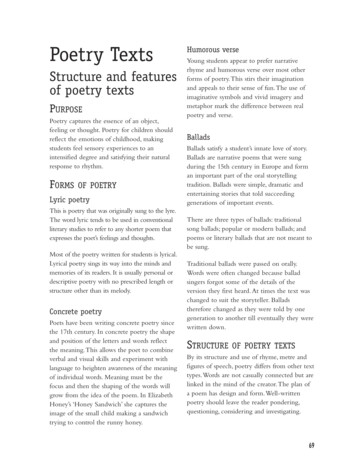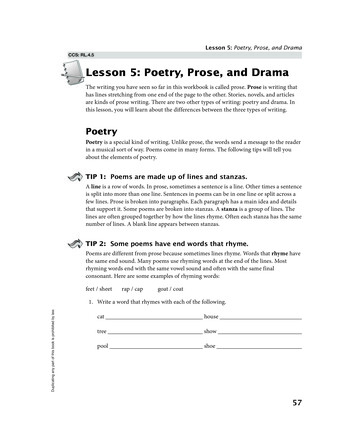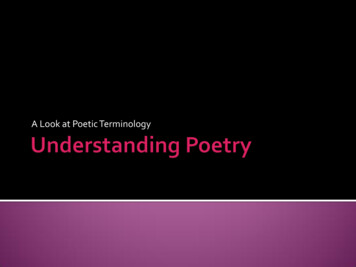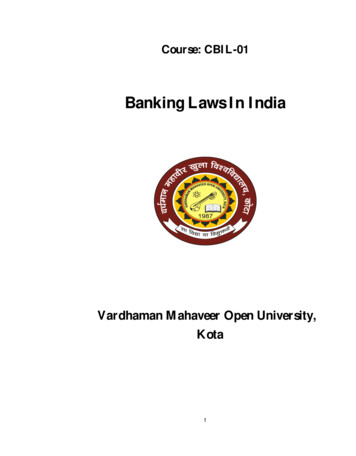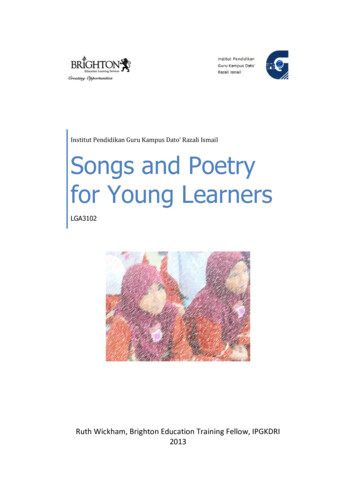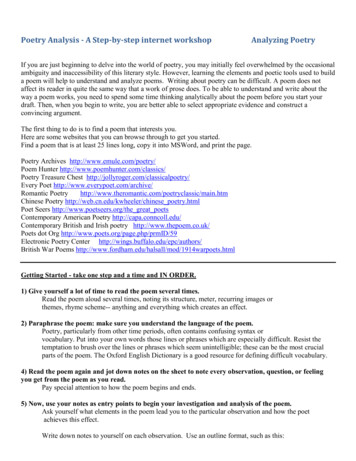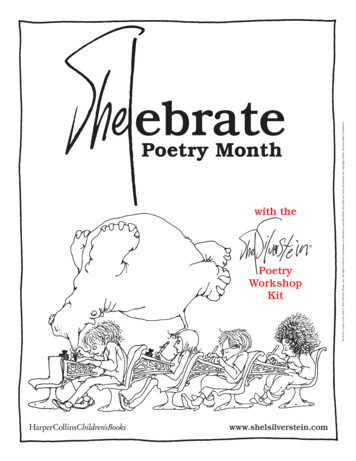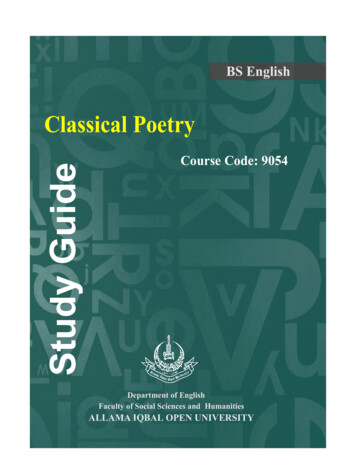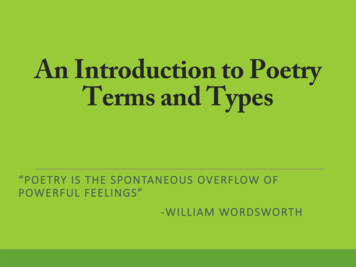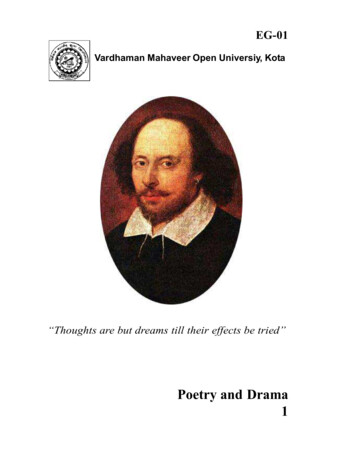
Transcription
EG-01Vardhaman Mahaveer Open Universiy, Kota“Thoughts are but dreams till their effects be tried”Poetry and Drama1
EG-01VARDHAMAN MAHAVEER OPEN UNIVERSIY, KOTABLOCK - 1PAGE -------Unit-IShakespeare : Shall I Compare theeUnit-IIShakespeare : Let me not to the marriage of true mindsUnit-IIIDonne : Death be not proudUnit-IVDonne : The Good MorrowUnit-VJohn Milton : On his blindenessUnit-VIJohn Milton : On his twenty third birthdayUnit-VIIJohn Dryden : A song for St. Cecilia’s DayUnit-VIIIAlexander Pope : An essay on manUnit-IXGray : Elegy written in country churchyardUnit-XWilliam Blake : The Chimney 118119-124BLOCK - 2Unit-XIShakespeare : The Merchant of VeniceUnit-XIIShakespeare : The Merchant of VeniceUnit-XIIIShakespeare : The Merchant of VeniceUnit-XIVShakespeare : Julius CaesarUnit-XVShakespeare : Julius CaesarUnit-XVIShakespeare : Julius CaesarUnit-XVIISocial and Cultural History from Caroline to ReformationUnit-XVIIIEnglish History and Literature from Elizabethan to Age of 236237-254255-264Poetry and Drama
Course Development CommitteeChairmanProf. (Dr.) Naresh DadhichVice ChancellorVardhaman Mahaveer Open University, KotaConvenorProf. (Dr.) Rajul BhargavaHOD Dept. of EnglishRajasthan University, JaipurMembers1.Dr. Joya Chakravarty2.Associate Professor (Eng.)University of Rajasthan,Jaipur4.CoordinatorDr. Kshamata ChaudharyConvenor, Dept. of EnglishVardhaman Mahaveer Open University,KotaDr. Rajesh Shukla3.Lecturer (Eng.)Government College,DausaDr. S.P. SinghLecturer (English)Agarwal College,JaipurDr. Suresh AgarwalAssociate Professor (Eng.)JRNRV University,Udaipur5. Dr. Sarita BangLecturer, Dept. of EnglishVedic Kanya PG College,JaipurEditor and Course WritersEditorProf.(Dr.) Rajul BhargavaHOD Dept. Of EnglishRajasthan University, JaipurUnit Writer1. Dr. Rajesh ShuklaLecturer EnglishGovt. College,Dausa3. Dr. Joya ChakravartyAssociate Prof. (English)University of Rajasthan,Jaipur5. Dr. Sunita AgarwalAssociate Prof. (English)University of Rajasthan,JaipurUnit Number(1,9,5,7)Unit WriterUnit Number2. Dr. Shalini BhargavaReader Dept. of EnglishArya Collage of EnggJaipur(2,4,6,14,15,16)4. Dr. Suresh AgarwalAssociate Prof. (English)JRNRV University,Udaipur(3,8,10)(11,12,13)(17,18)Course Supervision and ProductionDirector (Academic)Prof. (Dr.) Anam JaitlyVardhaman Mahaveer Open University,KotaDirector (Material Production & Distribution)Prof. (Dr.) P.K.SharmaVardhaman Mahaveer Open University,KotaProduction Oct. 2007All rights reserved. No part of this book may be reproduced in any form by mimeographor any other means, without permission in writing form the V.M.Open University, KotaPrinted and published on behalf of V.M.Open University, Kota by Director (Academic).
Block IntroductionBlock IThis block contains poetry in chronological order which cover a range of interesting, relevant themes and give pupils a taste of classical poetry, which have universalappeal and eternal value. Shakespeare’s sonnets immortalize ture love and friendshipwhere as Milton’s sonnets are intensely religious poems, with abundance of Biblicalquotations and an affirmation of christian faith and virtue.Besides Shakespeare and Milton you will read the poems of Dryden, lyrics ofDonne, Gray, Black and a satire of Pope. We hope you will enjoy reading this block.Block IThis block contains plays of William Shakespeare ,an renowned English playwright whose works are considered the greatest in the history of English Literature .Hisfamous comedy ‘The Merchant of Venice’partake less of farce and more of idyllic romance, while historical play ‘Julius Caesar’ successfully integrate political elementswith individual characterisation.This block also gives a detail study of literary ,social and cultural history from Elizabethan Age to The Age of Sensibility.We hope you will enjoy reading this block and get an insight regrarding thecharacteristics and themes in the plays.-----------------
Unit - 1Shakespeare: Shall I Compare ionAge and Author1.2.1 About the Age1.2.2 About the Sonnet1.2.3 About the Author1.2.4 Self Assessment QuestionsReading Text Shakespeare : Shall I Compare Thee1.3.1 Text1.3.2 Glossary1.3.3 Summary1.3.4 Critical Analysis1.3.5 Theme1.3.6 Style1.3.7 Self Assessment QuestionsLet Us Sum UpAnswers to the ExercisesBooks Suggested1.0Objectives1.3In this unit we will make you familiar with the poetry of William Shakespeare. Apartfrom being a dramatist par excellence, Shakespeare was also a poet of great merits.We will let you study one of the prominent sonnets of Shakespeare. We will give youpractice by:(i) giving the text of the sonnet of Shakespeare(ii) giving you meanings & explanations of difficult words and phrases(iii) critically analyzing the text and explaining the literary devices used in the sonnet(iv) giving you practice to answer questions based on the text.We will describe the literary scenario of the age of Shakespeare and see into his lifeand works, after giving an introduction about the age and the author. We will thendiscuss the text in detail and critically appreciate it. The unit will have exercises to helpyou evaluate your understanding. You can check your answer with the answers of theexercises given by us in section 1.5. Try to read and consult other related bookssuggested.1.1IntroductionIt happens very rarely in the history of literature that a craftsman who has acquiredperfect control of the medium and a masterly ease in handling the techniques andconventions of his day is also a universal genius of the highest order, combining withhis technical proficiency a unique ability to render experience in poetic language andan uncanny intuitive understanding of human psychology. William Shakespeare (1564– 1616) has a remarkable combination of all these qualities and has been praised forhis knowledge of the human psyche.1
In the Elizabethen age the art of words in England flourished without the sustaininginfluence of the other arts, in subsidiary forms. Further this art of words, which is theart of literature, gained great encouragement from the court and from the Queenherself. Yet even in Elizabethan times when literature seems to be so much at thecentre of the national life, it failed to command the attention of the nation as a whole.In later times the court has not often been as genial and as helpful as it was underQueen Elizabeth.It is strange that a country which has achieved so much in its literature should yethave regarded contemporary literature so often with indifference or, in some periods,even positive hostility. The governmental attitude to printing and to the general circulationof books was hostile from the times of Tudor to the beginnings of the eighteenthcentury and censorship acted in capricious form.When the Tudors granted a charter to the Stationer’s company in 1557, it was notwith any desire of improving the art of printing or of spreading learning or imaginativeliterature, but to license, control, suppress and watch more closely the activities ofprinters and publishers. It was on 29th June, 1566 that Queen Elizabeth signed adecree passed by the star chamber requiring every printer to enter into recognizancefor his good behaviour. No books were to be printed or imported without thesanction of a special commission of ecclesiastical authorities. Later in 1586 all printingwas restricted to London and the Universities of Oxford and Cambridge and allbooks had to be licensed. It was under the same period that inspite of great restrictions,some of the greatest literature in English was produced.The great writers did not have their works printed in good and beautiful books. Sowhile Shakespeare touched the resources of language in a way unmatched in anyperiod of English literature, his plays were published in wretched conditions that wereunsightly to read and whose texts were so carelessly reproduced that it has ever sincepuzzled the ingenuity of generations of commentators. Sonnets composed byShakespeare about love, became an irresistible poetical fashion during the decadefrom 1590 to 1600. The sonnets are of the English form, which is now generallyreferred as Shakespearean.1.2Age And AuthorIn this section we will discuss the sixteenth century with reference to the life, idealsand works of William Shakespeare, the greatest figure in English Literature.1.2.1 About the Age:With the revival of learning the study of the ancient Greek and Latin classicswas promoted. Reason came in for faith, hence began a revived interest in lifeand its pleasures, art, literature, science, and philosophy. This attitude is calledhumanism – concern with human instead of divine. Literature henceforthanswered the call of life.Long before Elizabeth I ascended the throne, the parliament, at the instanceof her father, Henry VIII, had declared the English church independent of thePope, making the king and his successors its heads and defenders of the faith.Elizabeth inherited this tradition. By the defeat of the Spanish Armada that had2
long posed a threat to the security of England another external obstacle to itsprogress was removed. It was a glorious epoch of English history. All the timethe message of the ancient Greek and Latin classics was flowing freely intothe century which, coupled with the blessings of peace and prosperity and theenlightened era of literary activity, flourished particularly in the fields of drama,poetry and criticism.Although James I, who succeeded Elizabeth, failed to follow in her footstepsand even in some areas reversed them, the glory that England achieved duringher reign lasted throughout his also. In literature it is common to extend theperiod of her influence to the end of James I’s reign.Although several kinds of verse forms were attempted in this age – the epicromance, the pastoral, the verse tale, the elegy, the sonnet, the lyric, the satire,it is mainly an age of the last three. Following close upon the heels of therenaissance, it availed itself of all that the Greek and Latin classics had to offerbut the form of whatever it chose to write is largely its own. It was ratherattempted and attracted by its matter. It is important to bear in mind becausein the seventeenth and eighteenth centuries the writers were more attracted byits form than by its matter.Ranking next only to drama, poetry proved no less popular. For the first timeit began to be published in anthologies. The first one was called after the nameof its printer, “Tuttle’s Miscellany”. This was originally called “Songs andSonnets written by Surrey and Others”. This collection of poetry representsthe first available instance of blank verse in English. Twenty years later “England’sHelion” published in 1600 had poems of Sidney, Spenser, Drayton, Lodge,Greece, Peek and Shakespeare.1.2.2 About the Sonnet:Sonnet was first introduced in England by Sir Thomas Wyatt and HenryHoward, Earl of Surrey in the first half of the sixteenth century. His sonnetsand those of his contemporary the Earl of Surrey were chiefly translationsfrom the Italian of Petrarch and the French of Ronsard and others. WhileWyatt introduced the sonnet into English, it was Surrey who gave them therhyme scheme, meter, and division into quatrains that now characterizes theEnglish sonnet. Sir Philip Sidney’s sequence Astrophil and Stella (1591)started a tremendous vogue for sonnet sequences: the next two decades sawsonnet sequences by William Shakespeare, Edmund Spenser, Michael Drayton,Samuel Daniel, Fulke Greville, William Drummond of Hawthornden, and manyothers.These sonnets were all essentially inspired by the Petrarchan tradition,and generally treat of the poet’s love for some woman; the exception isShakespeare’s sequence. In the 17th century, the sonnet was adapted to otherpurposes, with John Donne and George Herbert writing religious sonnets, andJohn Milton using the sonnet as a general meditative poem. Both theShakespearean and Petrarchan rhyme schemes were popular throughout thisperiod, as well as many variants. Writers, who followed Petrarch, wrote theirsonnets addressed to some lady, real or supposed. Love, therefore, is thesubject of sonnets, may it be for the sake of form or sometimes real. Where3
it is conventional, the lady is always heartless, the lover languishing for hersake, and sometimes even at the point of death, and so on.A variant on the English form is the Spenserian sonnet, named after EdmundSpenser (c.1552–1599) in which the rhyme scheme is, a-b a-b, b-c b-c, cd c-d, e-e. In a Spenserian sonnet there does not appear to be a requirementthat the initial octave set up a problem which the closing sestet answers, asis the case with a Petrarchan sonnet. Instead, the form is treated as threequatrains connected by the interlocking rhyme scheme and followed by acouplet. The linked rhymes of his quatrains suggest the linked rhymes of suchItalian forms as terza rima.Though the sonnet was originally brought over from Italy, it was the Frenchpractioners of the form that inspired the English writers. In general, the languageof the sonnets is rich and the verse musical. Thoughts, word and metre werehappily blended.Everyone who reads poetry knows Shakespeare’s Sonnets. The sonnetsinclude some of the most beautiful poems ever written. Sonnets, within theirforthright form, are the most exquisitely wrought creations of sound andsyllable in the language. Frequently they give compelling utterance toexperiences everyone goes through in love – anguish, elation, joy, dismay;and they realize with directness and fullness basic conditions of existencewhich love has to confront. Many of the sonnets of Shakespeare arewonderfully generous poems; they give meaning and beauty. The generosityis at once personal, a selfless love, and impersonal, the glow upon the worldwhen Shakespeare began to write. His poems create a world resonant withthe friend’s beauty. Each of his sonnet is one utterance. Shakespeare’s useof form is simple and forthright and also delicate and subtle. He never variesfrom three quatrains followed by a couplet, abab, cdcd, efef, gg.1.2.3 About the Author:Of William Shakespeare, in the biographical sense, we know too much andtoo little. The diligence of investigators has amassed a huge quantity ofinformation. Two great unassailable facts we do know and must never forget:first that a man named William Shakespeare lived and wrote, was seen bymany, admired for his works, liked for his qualities; and second that a greatmass of work was known by his friends and rivals to be his, was publishedas his by people, and was never doubted to be his by any contemporary orby any successor.It was in the nineteenth century in America, that some people began to throwup a succession of cranks, representing the extremes in relation to life andworks of Shakespeare. Some began to plead that plays of Shakespeare musthave been written by a member of the Peerage, who passed his first fewplays under the name of Shakespeare, and then when the name becamefamous and extremely popular, the peer could not but continue doing thesame. Some other were of the view that these plays were compressed byMarlowe, who passed them under the name of Shakespeare as he was beinginvolved in a case of murder and was underground. People have tried to4
make him a mystery, by trying to find reasons for what is beyond reason, “Allcreative genius is a mystery”.All these arguments have not been able to stand the test of time and the realShakespeare has remained a reality. It has doubled his greatness, as commonpeople try to create doubles and mysteries about the people who are great.The following entry in the register of baptism is relied upon in fixingShakespeare’s birth:“1564, April 26, Gulielmus Filins Johannes Shakespeare” [William Son (of)John].The practice was to baptize the child within a few days of his birth; so 23rdApril was fixed as Shakespeare’s birth date. His birth place was StratfordOn-Avon in Warwickshire, where his father John was a glover, a corn dealerand farmer. William was the first son and the third child of John and MaryArden, daughter of a husbandman and landowner. William is expected to joinschool at the age of six or seven, till he was sixteen, when due to his fatherJohn falling on evil days he had to be withdrawn from school. At eighteen hemarried Anne Hathway, his senior by eight years by special license onNovember 28, 1582. It was the sum of 6,1354d, which Anne received fromher father on her marriage, that attracted the penniless Shakespeare to marryher. His first daughter Susannah, was baptized on May 26, 1583. His twins,Hamnet and Judith, were baptized on February 2, 1585. Whether his marriagewas a happy one or not, is not known. Shakespeare of course dwells on theevils of a woman wedding one younger than herself in Twelfth Night (II, iv);of the disdain and discard which grow through such incompatible union in TheTempest (IV,i) and of a wife’s jealousy in The Comedy of Errors (V,i).In 1587 he left Stratford for London, and took the way to fame and fortune.There are many accounts of what he did in London. But one fact remains thatby 1592, he was actively engaged in writing plays and acting. About this timehe found a patron in Henry Wrothesley, Earl of Southampton. By 1596, hebecame wealthy enough to apply for a Coat of Arms.On August 11, 1596, his only son Hamnet died and was buried at Stratford.This must have been a great blow to him. On May 4, 1597 he bought for 60, the largest house in Stratford, New Place, and later on May 1, 1602he added one hundred and seven acres of land to New Place.He joined “The Theatre” on coming to London and when it was rebuilt as“The Globe” in 1599, he became its partner. He had formed his own company“The Lord Chamberlain’s Servants” to produce and act on stage. On KingJames I’s accession in 1603, his company assumed the title of “The King’sPlayers”. He married his daughter Susannah in 1607 to a wine merchant ofStratford. His father died in 1601 and on his mother’s death in 1609, hedecide to retire from London, after selling or releasing his shares of “TheGlobe”. He remained active in literary and social circles. In 1615 he finalisedand got hold of the little deeds of a house and land through the orders of LordChancellor from Anne Bacon, the mother of the great essayist Francis Bacon.5
He made his will in January 1616 and signed it on March 25, 1616. He diedon April 24, 1616 in the chancel of Stratford Church.Shakespeare’s life in London is an unbroken record of success and prosperity,and the rest of his story, so far as it can be read in records is one of continuedgood fortune.1.2.4 Self Assessment Questions:We are giving you here some questions to evaluate your understanding aboutElizabethan age and life of William Shakespeare.Exercise – 1Choose the correct answer from amongst the three alternatives given beloweach question:1. William Shakespeare was :(a) a great reformer(b) the biggest atheist(c) a universal Genius2. The Elizabethan age of literature was at the centre of:(a) National life(b) Creative Output(c) Imaginative writers3. Censorship on printing was first imposed during the reign of :(a) Queen Elizabeth(b) James I(c) Tudors4. The order to get the books licensed was passed in:(a) 1566(b) 1576(c) 15865. The Spanish Armada posed a threat to:(a) Security of England(b) Defense of Spain(c) Church of England6. Queen Elizabeth was succeeded by:(a) Charles I(b) Tudors(c) James I7. The English Church was declared independent of the Pope by:(a) Queen Elizabeth(b) Tudors(c) Henry VIII8. Sonnet belongs to:(a) Shakespeare(b) England(c) Italy6
9. Twins to Shakespeare were born on:(a) May 26, 1583(b) February 2, 1585(c) November 28, 158210. Shakespeare bought ‘New Place’ on:(a) May 4, 1597(b) August 11, 1596(c) May 6, 15971.4Reading Text (Shakespeare: Shall I Compare Thee)In this section we will give you practice to study and understand Shakespeare’sSonnet “Shall I Compare Thee”.This is one of the most famous of all the sonnets, justifiably so. But it would be amistake to take it entirely in isolation, for it links in with so many of the other sonnetsthrough the themes of the descriptive power of verse; the ability of the poet to depictthe fair youth adequately, or not; and the immortality conveyed through being hymnedin these ‘eternal lines’. It is noticeable that here the poet is full of confidence that hisverse will live as long as there are people drawing breath upon the earth, whereaslater he apologises for his poor wit and his humble lines which are inadequate toencompass all the youth’s excellence. Now, perhaps in the early days of his love,there is no such self-doubt and the eternal summer of the youth is preserved foreverin the poet’s lines. The poem also works at a rather curious level of achieving itsobjective through dispraise. The summer’s day is found to be lacking in so manyrespects (too short, too hot, too rough, sometimes too dingy), but curiously enoughone is left with the abiding impression that ‘the lovely boy’ is in fact like a summer’sday at its best, fair, warm, sunny, temperate, one of the darling buds of May, and thatall his beauty has been wonderfully highlighted by the comparison.1.3.1 Text:Given below is the text of William Shakespeare’s SonnetSHALL I COMPARE THEE1234567891011121314Shall I compare thee to a summer’s day?Thou art more lovely and more temperate :Rough winds do shake the darling buds of May,And summer’s lease hath all too short a date:Sometime too hot the eye of heaven shines,And often is his gold complexion dimm’d :And every fair sometime declines,By chance or nature’s changing course, untrimm’dBut thy eternal summer shall not fade,Nor lose possession of that fair thou owest :Nor shall death brag thou wander’st in his shade,When in eternal lines to time thou grow’st :So long as men can breathe or eyes can see,So long lives this, and this gives life to thee.7
1.3.2 Glossary:1-4 I:thee:thou:temperate:darling:buds of May:lease:5-8 too hot:the eye of heaven :gold:complexion:declines:untrimm’d:9-12 eternal:summer:fade:brag:in his shade:to time:growe’st:13-14 breathe:life:the poet Shakespearethe beauty of the poet’s friend W.H.you, the poet’s friendcalm and mildlovelyflowers that grow in month of Maylifein dazzling brightnesssunshining brightlyfaceto loose beautyfade awaypermanent, which is never to diminishbeautydisappear, declineto take awayunder its controlfor further or future timeto become permanentliveto make permanent1.4.3 ExplanationsShall I compare thee to a summer’s day?:This is taken usually to mean ‘What if I were to compare thee etc?’ The stockcomparisons of the loved one to all the beauteous things in nature hover inthe background throughout.Thou art more lovely and more temperate: The youth’s beauty is moreperfect than the beauty of a summer day.More temperate - more gentle, more restrained, whereas the summer’s daymight have violent excesses in store, such as are about to be described.Rough winds do shake the darling buds of May,: May was a summermonth in Shakespeare’s time, because the calendar in use lagged behind thetrue sidereal calendar by at least a fortnight darling buds of May - thebeautiful, much loved buds of the early summer; favourite flowers.And summer’s lease hath all too short a date:Legal terminology. The summer holds a lease on part of the year, but the leaseis too short, and has an early termination (date).Sometime too hot the eye of heaven shines,Sometime on occasion, sometimes; the eye of heaven the sun.And often is his gold complexion dimmed, his gold complexion his (thesun’s) golden face. It would be dimmed by clouds on overcast days generally.And every fair from fair sometime declines, All beautiful things (every fair)8
occasionally become inferior in comparison with their essential previous stateof beauty (from fair). They all decline from perfection.By chance, or nature’s changing course untrimmed:By chance accidents, or by the fluctuating tides of nature, which are notsubject to control, nature’s changing course untrimmed. untrimmed - thisrefers to the ballast (trimming) on a ship which keeps it stableNor lose possession of that fair thou ow’st,Nor shall it (your eternal summer) lose its hold on that beauty which you sorichly possess. ow’st ownest, possess. By metonymy we understand ‘norshall you lose any of your beauty’.When in eternal lines to time thou grow’st, in eternal lines in theundying lines of my verse. Perhaps with a reference to progeny, and lines ofdescent to time thou grow’st - you keep pace with time, you grow as timegrows.So long as men can breathe, or eyes can see,For as long as humans live and breathe upon the earth, for as long as thereare seeing eyes on the earth.So long lives this, and this gives life to thee. That is how long these verseswill live, celebrating you, and continually renewing your life.1.4.4 Summary:The poet does not feel inclined to compare his friend’s beauty to the beautyof a day in summer season. He believes that his friend his more mild, calmand beautiful than the beauty acquired by a day of summer. The beauty whichwe witness in a summer’s day is very short lived. The good and beautifulflowers are shaken away and broken down by wild winds, hence, theirbeauty is short lived.During summer the sun is sometimes very hot and dazzles very brightly, butsometimes when its rays are covered by clouds, its shine becomes dim. Everybeautiful thing in this world looses its beauty and charm, either suddenly orin due course of time.But the beauty of his friend is eternal and thus will never become less. It isimmortal it will neither fade nor decline. The poet is confident that his friend’sbeauty would not be taken away even after death. It is eternal and permanent.It would increase with the passage of time. He says that he has immortalizedhis friend’s beauty through this sonnet, and as long as this sonnet would beread by people, his friend’s beauty would remain alive.1.4.5 Critical Analysis:Shakespeare wrote 154 sonnets in all. The first 126 sonnets are addressedto his friend W.H., while the other 26 sonnets are conventional exercises inverse. The present sonnet is No. 66. The poet points out that every beautifulthing in nature is sure to decline either abruptly or in due course of nature’stime.9
But the intellectual and spiritual beauty of his friend W.H. is eternal as it cannotbe diminished by the passing of time like other objects. It, on the other hand,will grow permanent because it has been immortalished through this sonnet. Solong as this written literature remains, and people read this poem, the beautyof his friend will survive’s unlike other objects of beauty.The sonnet is addressed to W.H. This young man may have been HenryWriothesley, Earl of Southampton or Sir Philip Sidney’s nephew, WilliamHerbert, Third Earl of Pembroke.1.4.6 Theme:The theme of this sonnets, as of the other 153 addressed to W.H. is thepermanence and supremacy of love. This is a recurring theme in other sonnetsof Shakespeare. The poet gives an assurance of poetic immortality, love andfriendship. So long as the written word remains and this poem is read in future,the beauty of his friend, and the poets’ love for his friend would remain alivein the heart, eyes and mind of the readers. It proves the power of writtenwords, which would prove mighter than the law of nature.1.4.7 Style:This sonnet has been composed in the format of English Sonnet, popularlyknown as the Shakespearean Sonnet. It has three quartrains of four lines eachand a two lines couplet at the end. Two characteristics of Shakespeare standout. The first is known as cantabolic. This refers to the work of someonewhose ear is unerring. He is intent upon making his verse as melodious, in thesimplest and most obvious sense of the word, as possible and there is scarcelya line, which is out of rhyme, rhythm or tune.The second characteristic that this sonnet displays is a mystery of every possiblerhetorical device. It avoids the monotony. On the whole the style is verywholesome and powerful. It catches the attention of the reader and makes himbelieve to be true whatever he reads.1.4.8 Self Assessment Questions:You have gone through the marvelous sonnet of Shakespeare and haveunderstood the content, theme, style and the idea of the poet. Now answerthe following questions:1.2.The sonnets addressed to the Dark Lady are:(a) 26(b) 54(c) 24Shakespeare addressed 126 sonnets to:(a) H.W.(b) D.L.(c) W.H.10
3.4.5.The ‘eyes of the heaven’ are:(a) The sun(b) The God(c) The poetDeath can not take away the:(a) Beauty of W.H.(b) Power of heaven(c) The laws of natureMore powerful than nature and heaven is:(a) Beauty(b) Poem(c) SunExercise – 3Answer the following questions in your own words:1.2.3.4.5.1.5Discuss the theme of the sonnet you have read.What would the poet immortalise?What happens to things of beauty?Discuss the structure of “Shall I Compare Thee”.How does Shakespeare describe the sun and its brightness?Let Us Sum UpIn this unit you have acquired knowledge and had practice:(i)(ii)(iii)(iv)(v)(vi)1.6to understand the sonnets,to understand the Elizabethan age,to know about life of Shakespeareto know and understand various literary trends of the Elizabethan age,to critically analysis Shakespeare’s sonnetto understand, analyse and appreciate the poem and answer the questions basedon it in your own words.Answers To The ExercisesExercise – 11. (c) Universal genius2. (a) National life3. (c) Tudor4. (c) 15865. (a) Security of England6. (c) James-I7. (c) Henry VIII8. (c) Italy9. (b) February 2, 158510. (a) May 4, 159711
Exercise – 21. (a) 262. (c) W.H.3. (a) The sun4. (a) Beauty of W.H.5. (b) PoemExercise – 31. The beauty of a person is imm
1.6 Books Suggested 1.0 Objectives In this unit we will make you familiar with the poetry of William Shakespeare. Apart from being a dramatist par excellence, Shakespeare was also a poet of great merit s. We will let you study one of the prominent sonnets of Shakespeare. We will give you practice by: (i) giving the text of the sonnet of Shakespeare
